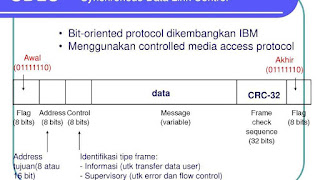Synchronous Data Link Control (SDLC) is a computer communications protocol. It is the layer 2 protocol for IBM's Systems Network Architecture (SNA). SDLC supports multipoint links as well as error correction. It also runs under the assumption that an SNA header is present after the SDLC header. SDLC was mainly used by IBM mainframe and midrange systems; however, implementations exist on many platforms from many vendors. The use of SDLC (and SNA) is becoming more and more rare, mostly replaced by IP-based protocols or being tunneled through IP (using AnyNet or other technologies).
In 1975, IBM developed the first bit-oriented protocol, SDLC, from work done for IBM in the early 1970s. This de facto standard has been adopted by ISO as High-Level Data Link Control (HDLC) in 1979 and by ANSI as Advanced Data Communication Control Procedures (ADCCP). The latter standards added features such as the Asynchronous Balanced Mode, frame sizes that did not need to be multiples of bit-octets, but also removed some of the procedures and messages (such as the TEST message).
SDLC operates independently on each communications link, and can operate on point-to-point multipoint or loop facilities, on switched or dedicated, two-wire or four-wire circuits, and with full-duplex and half-duplex operation. A unique characteristic of SDLC is its ability to mix half-duplex secondary stations with full-duplex primary stations on four-wire circuits, thus reducing the cost of dedicated facilities.
Intel used SDLC as a base protocol for BITBUS, still popular in Europe as fieldbus and included support in several controllers (i8044/i8344, i80152). The 8044 controller is still in production by third party vendors. Other vendors putting hardware support for SDLC (and the slightly different HDLC) into communication controller chips of the 1980s included Intel, Zilog, Motorola, and National Semiconductor. As a result, a wide variety of equipment in the 1980s used it and it was very common in the mainframe centric corporate networks which were the norm in the 1980s. The most common alternatives for SNA with SDLC were probably DECnet with Digital Data Communications Message Protocol (DDCMP), Burroughs Network Architecture (BNA) with Burroughs Data Link Control (BDLC), and ARPANET with IMPs.
Video Synchronous Data Link Control
Notes
Maps Synchronous Data Link Control
References
- System Network Architecture: An Overview, J. McFadyen, IBM Systems Journal, Volume 15, Issue 1, pp. 4-23 (1976).
- Odom, Wendell (2004). CCNA INTRO Exam Certification Guide: CCNA Self-study. Indianapolis, IN: Cisco Press. ISBN 1-58720-094-5.
- Friend, George E.; John L. Fike; H. Charles Baker; John C. Bellamy (1988). Understanding Data Communications (2nd ed.). Indianapolis: Howard W. Sams & Company. ISBN 0-672-27270-9.
- Pooch, Udo W.; William H. Greene; Gary G. Moss (1983). Telecommunications and Networking. Boston: Little, Brown and Company. ISBN 0-316-71498-4.
- Hura, Gurdeep S.; Mukesh Singhal (2001). Data and computer communications: networking and internetworking. Indianapolis: CRC Press. ISBN 0-8493-0928-X.
External links
- Cisco page on Synchronous Data Link Control and Derivatives
- Bitbus/fieldbus community site.
Source of the article : Wikipedia

